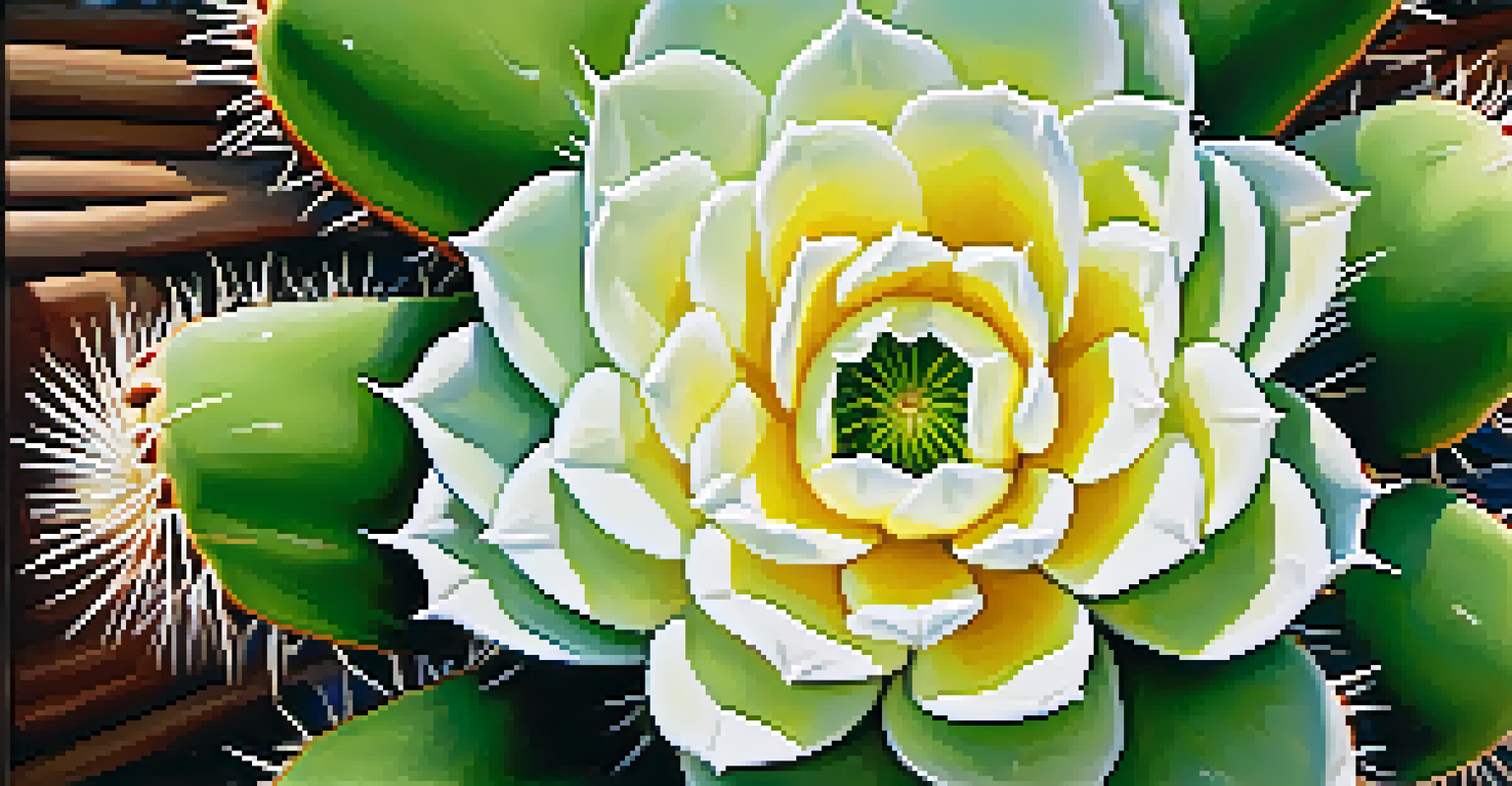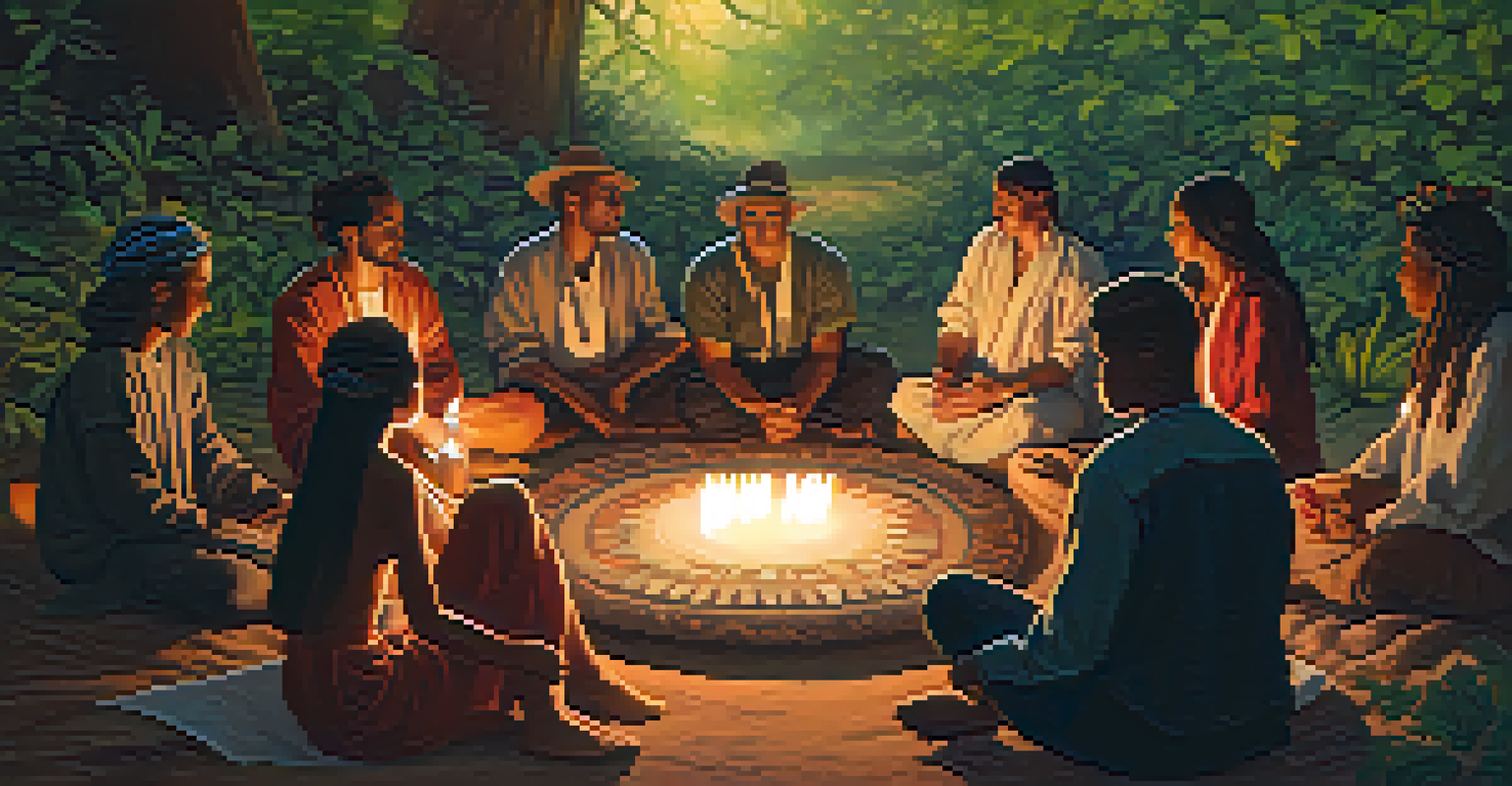The Spiritual Journey: Peyote and Community Connection

Understanding Peyote: A Sacred Plant with a Purpose
Peyote is a small cactus native to the southwestern United States and Mexico, known for its psychoactive properties. For centuries, it has served as a key element in various spiritual practices, particularly among Indigenous communities. The plant contains mescaline, a compound that induces altered states of consciousness, allowing users to embark on profound spiritual journeys.
The use of peyote is a journey into the depths of one’s spirit, where healing and understanding can emerge.
In many cultures, peyote is revered not just for its effects but for its role in connecting individuals to the divine and to one another. It’s often used in ceremonial settings, where participants seek healing, insight, or a deeper understanding of themselves and their place in the universe. This sacred use underlines the plant’s significance beyond mere recreational use.
Engaging with peyote can lead to experiences that foster personal growth and community bonding. As participants share their journeys, they contribute to a collective understanding that transcends individual experiences, reinforcing the importance of community in the spiritual realm.
The Role of Ceremony in Peyote Use
Ceremonies involving peyote are deeply rooted in tradition and often include rituals that guide participants through their spiritual experiences. These gatherings typically feature prayers, songs, and community storytelling, all designed to create a safe and sacred space for exploration. The ceremonial aspect not only enhances the effects of peyote but also reinforces the bonds between participants.

During these ceremonies, individuals may experience visions or insights that help them navigate personal challenges or understand their life’s purpose. The shared nature of these experiences fosters a sense of unity, as participants support one another on their spiritual paths. This communal aspect can lead to lasting friendships and a strong sense of belonging.
Peyote's Role in Spiritual Practices
Peyote is revered in Indigenous cultures for its ability to facilitate deep spiritual experiences and community connections.
Moreover, the structure of these ceremonies promotes mindfulness and respect, encouraging participants to honor the plant and the traditions surrounding its use. By participating in a ceremony, individuals not only seek personal transformation but also contribute to the preservation of cultural heritage and community values.
Peyote and Indigenous Spiritual Practices
For many Indigenous peoples, peyote is integral to spiritual practices and cultural identity. The use of peyote is often tied to specific rituals and beliefs, emphasizing the deep connection between the plant and the community’s heritage. This relationship showcases how spirituality and cultural identity can intertwine, creating a robust framework for personal and communal growth.
Cultural appreciation is about honoring traditions with respect and understanding, fostering genuine connections.
The Native American Church, for example, incorporates peyote into its sacramental ceremonies, viewing it as a means of communion with the Creator. These practices highlight the importance of respecting the plant and the teachings it offers, ensuring that its use is both responsible and meaningful. This sacred approach serves as a reminder of the reverence with which the plant should be treated.
As non-Indigenous individuals seek to explore these spiritual practices, it is crucial to approach with respect and understanding. Engaging in dialogue and learning from Indigenous voices helps bridge cultural gaps, promoting a more profound appreciation for the wisdom embedded in these traditions.
Community Connections Through Shared Experiences
Shared experiences during peyote ceremonies can create powerful bonds among participants. As individuals navigate their personal journeys together, they often find common ground, fostering empathy and understanding. This collective experience not only enhances personal growth but also strengthens community ties, making each participant feel valued and connected.
When people openly share their visions and insights, it can lead to meaningful discussions that deepen relationships. These conversations often extend beyond the ceremony, contributing to ongoing support networks where individuals feel safe to explore their spirituality and life challenges. This sense of community can be incredibly healing, especially for those who may feel isolated in their everyday lives.
Ceremonies Foster Community Bonds
Ceremonies involving peyote create a supportive environment that enhances personal growth and strengthens relationships among participants.
Moreover, these connections often inspire participants to engage in community service or support initiatives that benefit the wider community. The transformative power of shared experiences can motivate individuals to contribute positively, creating a ripple effect that enriches the lives of many.
Healing and Personal Transformation Through Peyote
Many individuals turn to peyote for healing and personal transformation. The insights gained during ceremonies can help illuminate personal issues, traumas, or patterns that need addressing. By confronting these challenges in a supportive environment, participants can begin to heal and cultivate a more positive outlook on life.
The therapeutic aspects of peyote have drawn attention from both spiritual practitioners and mental health professionals. While research is still ongoing, anecdotal evidence suggests that peyote can assist in alleviating symptoms of depression, anxiety, and PTSD. This growing interest highlights the potential of integrating traditional practices with modern therapeutic approaches.
Ultimately, healing through peyote is a deeply personal journey, with each individual finding their path. The support of a community can enhance this process, providing a network of understanding and compassion that encourages growth and resilience.
Cultural Appropriation vs. Cultural Appreciation
As interest in peyote and Indigenous spiritual practices grows, it’s essential to navigate the fine line between cultural appropriation and cultural appreciation. Many Indigenous communities have expressed concerns about outsiders using peyote without understanding its significance or respecting its sacredness. This dialogue emphasizes the importance of awareness and sensitivity when engaging with these traditions.
Cultural appreciation involves a genuine effort to understand and honor the practices of Indigenous peoples, often through education and respectful participation. This means listening to Indigenous voices, supporting their rights, and engaging in cultural exchanges that are mutually beneficial. By approaching these practices with humility and respect, individuals can foster meaningful connections.
Cultural Respect is Essential
Understanding the difference between cultural appropriation and appreciation is vital for those interested in engaging with peyote traditions respectfully.
Conversely, cultural appropriation often manifests as a superficial or exploitative engagement that disregards the deeper meanings and values associated with the practice. It’s crucial for those interested in peyote to reflect on their intentions and seek ways to connect that honor the tradition and its people.
The Future of Peyote Use in a Modern Context
As society evolves, the future of peyote use and its integration into broader spiritual practices remains a topic of interest. Increased awareness of mental health and holistic healing has led many to explore alternative paths, including the use of peyote. This growing recognition can lead to a greater appreciation for Indigenous practices and the wisdom they offer.
However, this shift also raises important questions about sustainability and ethical usage. The peyote cactus is endangered in some regions, prompting discussions about responsible harvesting and conservation efforts. Balancing the desire for personal exploration with environmental stewardship is critical to ensure that future generations can access this sacred plant.

Ultimately, the future of peyote use will depend on how well we respect and integrate its cultural significance while promoting responsible practices. By fostering dialogue and collaboration between Indigenous communities and seekers, we can create a more inclusive and sustainable approach to spiritual exploration.